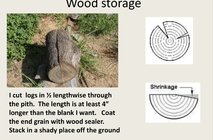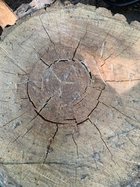Last fall I had an old ash tree fall and destroyed my camper. I saved as much of the wood as I could salvage and have turned some of it. Just looked at that pile earlier looking for a piece to turn. I had sealed all ends heavily with yellow carpenters glue so I thought I was safe... yea, that's what I get for thinking, right? LOL Seems like every piece I have left, limbs and trunk has severe ring shake with heavy radial (?) cracks leading outward. I mean not just hairline fractures, but gapping holes/ring shake. I'm guessing it's not how I stored it in a covered shed? Is it possible it developed it while drying out? Or is it possible because the tree came down violently it was caused then and I just did not see it?
I guess I will split what's left for the firewood pile. Atleast is should... burn good.
I guess I will split what's left for the firewood pile. Atleast is should... burn good.


